3Ds Max Artist Docs
This part of documentation is still work in progress.
First Steps With AYON
Locate AYON Icon in the OS tray (if hidden dive in the tray toolbar).
If you cannot locate the AYON icon ...it is not probably running so check Getting Started first.
By clicking the icon AYON Menu rolls out.

Choose AYON Menu > Launcher to open the Launcher window.
When opened you can choose the project to work in from the list. Then choose the particular asset you want to work on then choose task and finally run 3dsmax by its icon in the tools.

The list of available projects, assets, tasks and tools will differ according to your Studio and need to be set in advance by supervisor/admin.
Running in the 3dsmax
If 3dsmax has been launched via OP Launcher there should be AYON Menu visible in 3dsmax top header after start. This is the core functional area for you as a user. Most of your actions will take place here.
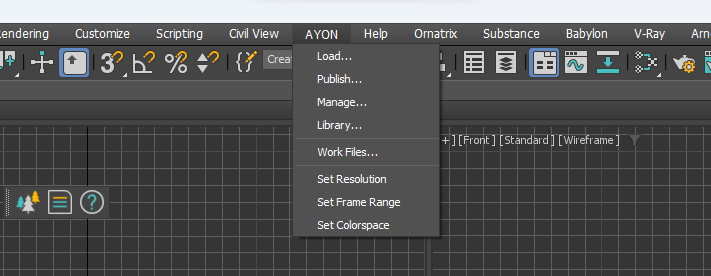
User should use this menu exclusively for Opening/Saving when dealing with work files not standard File Menu even though user still being able perform file operations via this menu but preferably just performing quick saves during work session not saving actual workfile versions.
Working With Scene Files
In AYON menu first go to Work Files menu item so Work Files Window shows up.
Here you can perform Save / Load actions as you would normally do with File Save and File Open in the standard 3dsmax File Menu and navigate to different project components like assets, tasks, workfiles etc.

You first choose particular asset and assigned task and corresponding workfile you would like to open.
If not any workfile present simply hit Save As and keep Subversion empty and hit Ok.

AYON correctly names it and add version to the workfile. This basically happens whenever user trigger Save As action. Resulting into incremental version numbers like
workfileName_v001
workfileName_v002
etc.
Basically meaning user is free of guessing what is the correct naming and other necessities to keep everything in order and managed.
Note: user still has also other options for naming like
Subversion,Artist's Notebut we won't dive into those now.
Here you can see resulting work file after Save As action.

Understanding Context
As seen on our example AYON created pretty first workfile and named it il_asset_art_v002.max meaning it sits in the Project il being it asset asset and workfile being art task and obviously v002 telling user its first existing version of this workfile.
It is good to be aware that whenever you as a user choose asset and task you happen to be in so called context meaning that all user actions are in relation with particular asset. This could be quickly seen in host application header and AYON Menu and its accompanying tools.

Whenever you choose different
assetand itstaskin Work Files window you are basically changing context to the current asset/task you have chosen.
This concludes the basics of working with workfiles in 3dsmax using AYON and its tools. Following chapters will cover other aspects like creating multiple assets types and their publishing for later usage in the production.
Creating and Publishing Instances
Before proceeding further please check Glossary and What Is Publishing? So you have clear idea about terminology.
Intro
Current AYON integration (ver 3.15.4) supports only PointCache, Camera, MaxScene, Render, PointCloud
TyCache, RedshiftProxy and Review product types now.
Pointcache product type being basically any geometry outputted as Alembic cache (.abc) format
Camera product type being 3dsmax Camera object with/without animation outputted as native .max, FBX, Alembic format
MaxScene product type being 3dsmax scene outputted as native .max format
Render product type being 3dsmax scene submitted to AWS Thinkbox Deadline. Currently supports 3dsmax standard renderers, Vray and Redshift for multipass submissions. Only supports Arnold for beauty (RGBA) render submission.
Point Cloud and TyCache product type being 3dsmax cache generated from tyFlow plugin and outputted as PRT(Pointcloud)/TYC(TyCache) format. As tyFlow is an external plugin from 3dsmax, make sure to get it install before using the product types.
Redshift Proxy product type being 3dsmax objects converted and outputted as RS format. As Redshift is an external plugin from 3dsmax, user require to install redshift before using the product type.
Review product type being 3dsmax scene creating preview animation and outputted as video and image sequences(if users select keep image sequences)
Publishing Point Cache (Alembic)
Simply select any animated geometry you want to export as alembic format and go AYON -> Create and select Point Cache. Make sure to keep your geometry selected before Publish. The output format of the geometry is Alembic (abc).
Loading Point Cache
When you load the Point Cache via AYON -> Load, it creates the container which includes the Alembic object parented to the point cache object.
Publishing Camera
Select the camera you want to export and go AYON -> Create and select Camera. User can go Publish and decide the export options by turning on/off the camera extractors.

The exported Alembic from the current alembic extractor may only be loaded in Max. It may not be compatible with the alembic loader in other DCCs such as Maya.
Loading Camera
The loader provides several options to load camera. You can import camera in either native Max, Fbx and Alembic (abc) format.
Similar to the Point Cache Instance, the Alembic camera loader will creates the container which includes the Alembic object parented to the point cache object.
The Fbx and max scene Loader import the published camera object which is parented to the newly created container.
Publishing MaxScene
Select any type of objects in the scene you want to export and go AYON -> Create and select Max Scene.
Loading MaxScene
Similar to other max scene loader, it will create the new containers which includes the published max scene object.
Render
After choosing your render setting, select the target camera for rendering in the scene and go AYON -> Create and select Render. When you go to Publish, you can set up the preferences in either creator or AYON setting before the deadline submission.
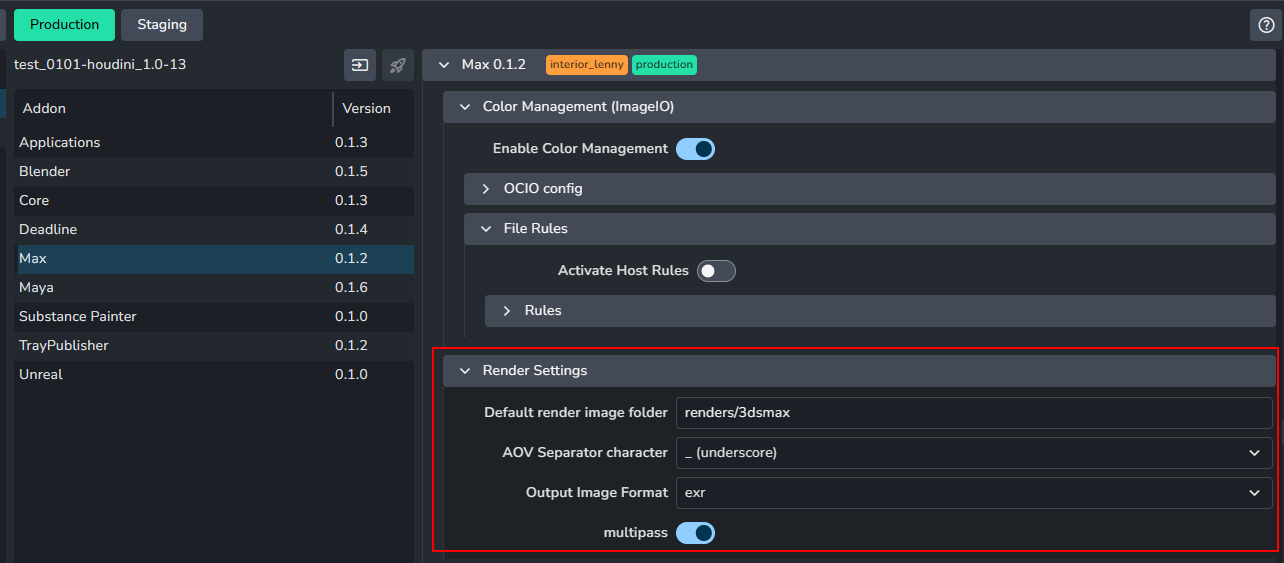

The Render Instance supports AOV renders for VRay, Redshift, and 3dsMax default renderers(i.e QuickSliver Hardware Renderer, ART Renderer, Scanline Renderer, VUE File Renderer). Merely supports beauty render for Arnold due to the pymxs API limitation.
Make sure removing the old render instance and create the new one if you switch from one renderer to another
Point Cloud/TyCache
Point Cloud Instance only works when tyFlow plugin installed in 3dsmax TyCache Instance only works when tyFlow Pro plugin installed in 3dsmax
Publishing Point Cloud
Select the tyFlow object(s) you want to export and go AYON -> Create and select Point Cloud. The exported object(s) would be in PRT format You can add the attributes which needs to be exported in AYON setting before publishing.

Publishing TyCache
Select the tyFlow object(s) you want to export and go AYON -> Create and select TyCache, you can choose the attribute data of tyCache to be exported in TYC format.
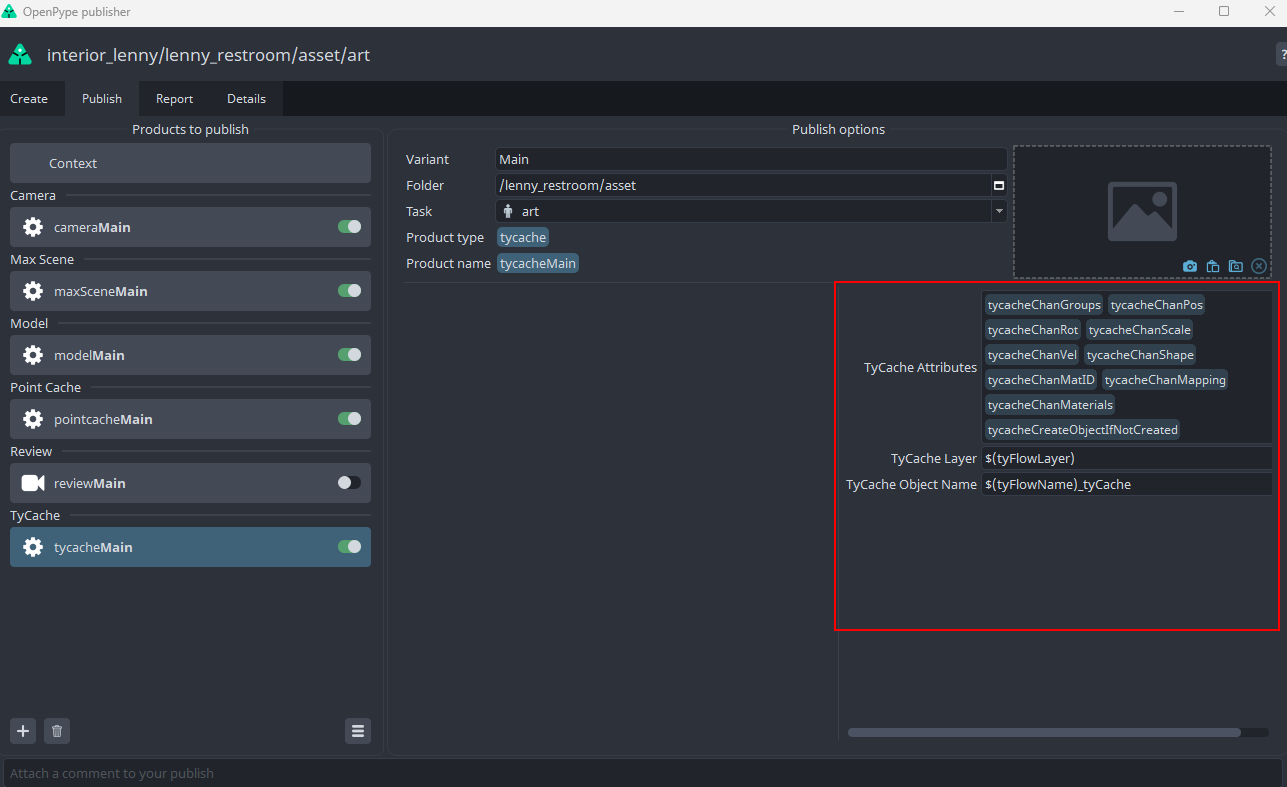
For users to have more information to know what the attributes they are exporting.
Channels
Age : tycacheChanAge, Groups: "tycacheChanGroups", Position: "tycacheChanPos", Rotation: "tycacheChanRot", Scale: "tycacheChanScale", Velocity: "tycacheChanVel", Spin: "tycacheChanSpin", Shape: "tycacheChanShape", Material ID: "tycacheChanMatID", Mapping: "tycacheChanMapping", Materials: "tycacheChanMaterials", Custom Float: "tycacheChanCustomFloat", Custom Vectors: "tycacheChanCustomVector", Custom TMs: "tycacheChanCustomTM", PhysX Data: "tycacheChanPhysX"
Mesh Files
Backup at regular itnervals: "tycacheMeshBackup"
Geometry Settings
Include cloth geometry: "tycacheAdditionalCloth", Include actor skinned meshes: "tycacheAdditionalSkin", Include actor skinned meshes ID: "tycacheAdditionalSkinID", Include actor skinned meshes ID value: "tycacheAdditionalSkinIDValue", Include terrain geometry:"tycacheAdditionalTerrain", Include VDB geometry: "tycacheAdditionalVDB", Include spline path geometry: "tycacheAdditionalSplinePaths", Include additional geometry: "tycacheAdditionalGeo", Activate render-only modifiers: "tycacheAdditionalGeoActivateModifiers"
Splines Settings
Include Spline Paths operators: "tycacheSplines", Include additional splines: "tycacheSplinesAdditionalSplines"
Loading Point Cloud/TyCache
When you load the point cloud through AYON -> Load, Max will create tycache object in the 3dsmax modifier's list and load the published PRT.
Publishing Redshift Proxy
Redshift Proxy only works when Redshift is installed in 3dsMax and it is the current renderer in the scene.
Select the object(s) you want to convert as redshift proxy and go AYON -> Create and select RedshiftProxy. The exported objects will be outputted as RS format.
Loading Redshift Proxy
You can load the redshift proxy through AYON -> Load, it will then load the redshift proxy with the converted object(s).
Review
Select the target camera you want to create preview animation and go AYON -> Create and select Review.You can set up the preferences(e.g. resolution) with the creator or AYON setting before creating the instance.
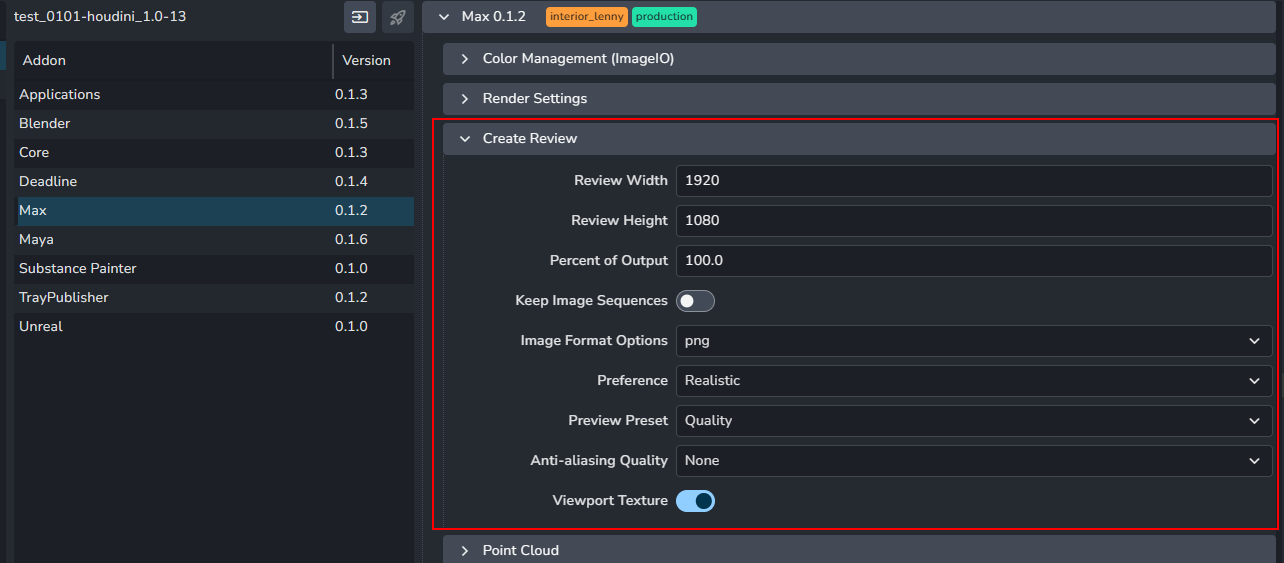
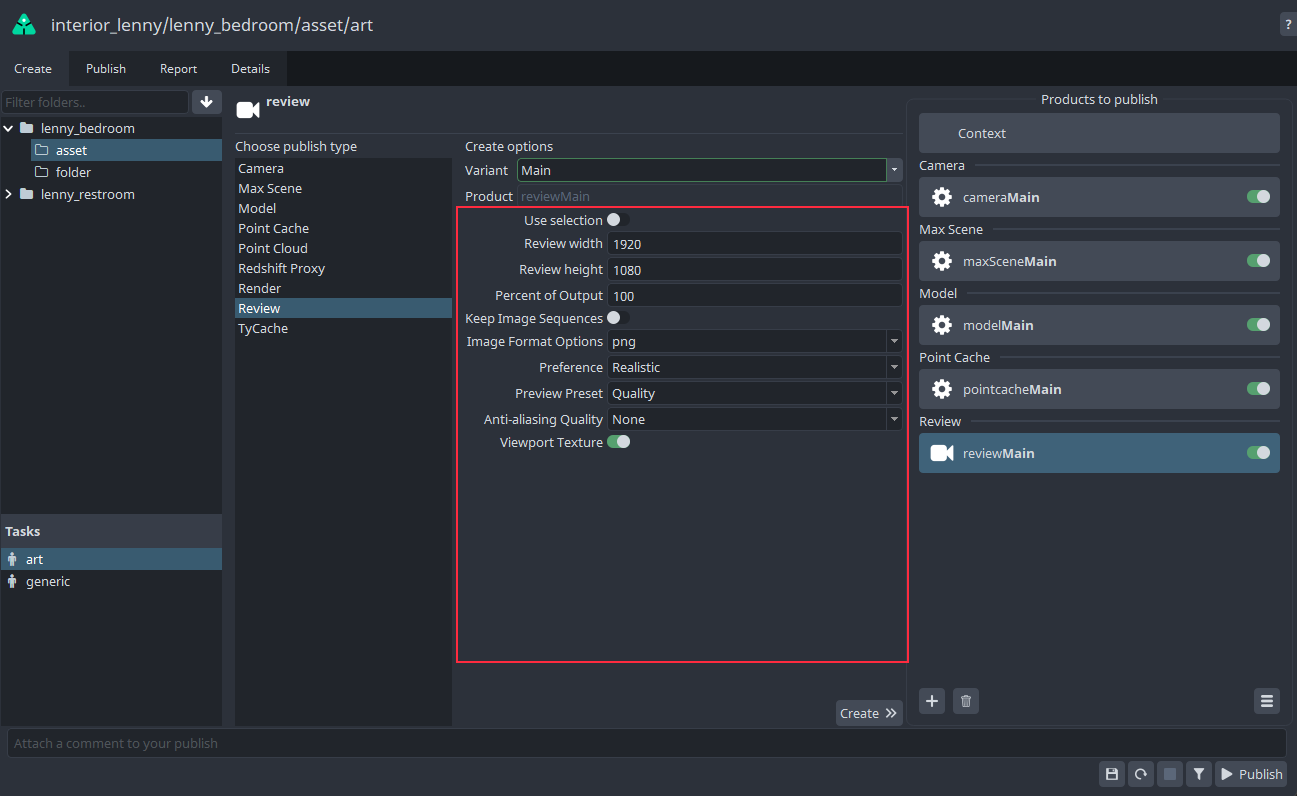
You can always edit if you want to create preview animation with different settings. You can also choose what to include in the preview animation.

Validators
Validate Frame Range
This validator is optional to check if the frame range in the scene aligns with that in the AYON project settings. You can switch on/ off in either the project settings in AYON setting or the toggled button in Publisher Tab.
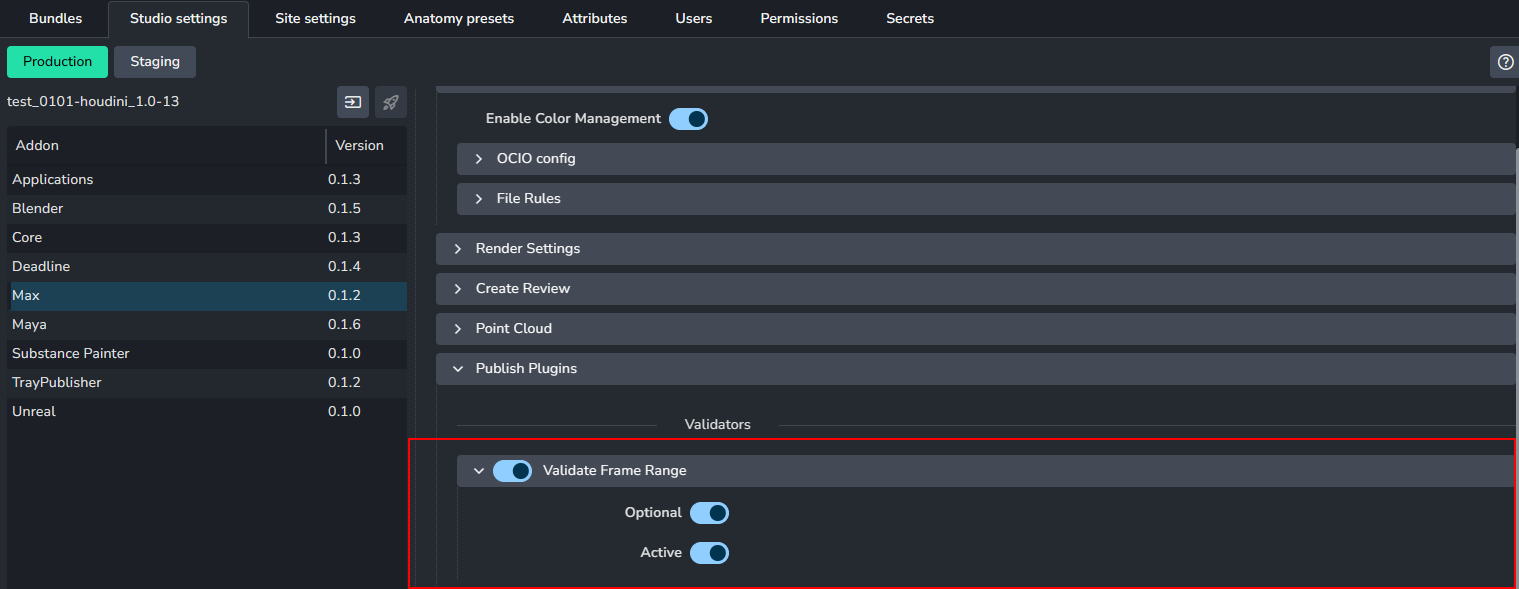

Validate Attributes
This validator is to make sure the property attributes are valid in 3dsMax. You need to put the data in JSON format in the AYON setting for attributes check.

E.g. If you want to check if renderers.current.separateAovFiles=true or
renderers.current.MotionBlurShutterAngle=160.5 etc..
{
"renderers.current": {
"separateAovFiles": true,
"MotionBlurShutterAngle": 160.5,
"PrimaryGIEngine": "#RS_GIENGINE_BRUTE_FORCE",
"OCIOViewName": "ACES 1.0 SDR-video"
}
}
Validate Loaded Plugin
This validator ensures the plugins are available for certain product types before publishing instances in 3dsMax.
You need to click + button to add product type and the plugins you want to validate within it.


